

Ulrich Frank, David Heise, Heiko Kattenstroth Use of a Domain Specific Modeling Language for Realizing Versatile Dashboards for Realizing Versatile Dashboards Chair of Information Systems and Enterprise Modeling University of Duisburg-Essen Germany University of Duisburg Essen, Germany Presentation at the 9th OOPSLA Workshop on Domain-Specific Modeling Institute for Computer Science and Business Information Systems (ICB) y ( )
M ti Motivation ti � Management of (parts of) enterprises requires an instrument to manage performance, e.g., � of a business unit � of a business unit � of a business process � of an IT resource, e.g., an information system � Increasing demand for indicators and sets of interrelated indicators („indicator systems“) … � … and corresponding performance management information systems! 2 Ulrich Frank, David Heise, Heiko Kattenstroth | October 25th, 2009
Indicators and Indicator Systems: Examples I di t d I di t S t E l Indicator System „Top Management“ ? Return on Costs of Business Sales Volume Managers Investment Number of Processes Sales Indicator System „Business Process Owner“ Indicator System Business Process Owner“ Quality of Business Througput of Process Costs of Business Processes Business Processes Owners Processes ? ? Indicator System „IT Management“ y „ g CMM-level of Costs of IT No. of incidents IT Managers software department of an ERP system 3 Ulrich Frank, David Heise, Heiko Kattenstroth | October 25th, 2009
Th The approach in a nutshell h i t h ll Domain-Specific Modeling Language (DSML) for indicator systems integrated with a method for multi-perspective enterprise modeling � Promises benefits at build time � Promises benefits at build-time … � promotes consistency of indicator systems � fosters adequate interpretation of indicators � serves as conceptual foundation for software development se es as concept al fo ndation fo soft a e de elopment � … but also at run-time (“ model-based dashboards ”) � opens up new functionalities and types of analyses � opens up new functionalities and types of analyses � allows to benefit from the specific advantages of domain- specific modeling languages at run-time, too 4 Ulrich Frank, David Heise, Heiko Kattenstroth | October 25th, 2009
L Language design: Meta Model d i M t M d l 5 Ulrich Frank, David Heise, Heiko Kattenstroth | October 25th, 2009
E Example: DSML-based Indicator System (build-time) l DSML b d I di t S t (b ild ti ) Description: Calculated as the time between reporting a ticket and the resolution of the corresponding incident Purpose: Indicate performance of the service desk Presumptions: Low average incident resolution time indicates good performance of the service desk; low average resolution time does not necessarily correspond with good quality of service; may lead to oversized service desks Preferred Visualisation: traffic light Benchmark: 30 minutes Data Source: Self.Benchmark : [ResolutionTime – InitTime] * 100 6 Ulrich Frank, David Heise, Heiko Kattenstroth | October 25th, 2009
A Architecture & Integration hit t & I t ti 7 Ulrich Frank, David Heise, Heiko Kattenstroth | October 25th, 2009
Example: Model-based Dashboard (run-time) (1/3) E l M d l b d D hb d ( ti ) (1/3) Manager g 8 Ulrich Frank, David Heise, Heiko Kattenstroth | October 25th, 2009
Example: Model-based Dashboard (run-time) (2/3) E l M d l b d D hb d ( ti ) (2/3) Process Owner „Online Sales“ 9 Ulrich Frank, David Heise, Heiko Kattenstroth | October 25th, 2009
Example: Model-based Dashboard (run-time) (3/3) E l M d l b d D hb d ( ti ) (3/3) IT Manager g 10 Ulrich Frank, David Heise, Heiko Kattenstroth | October 25th, 2009
Q Questions, Answers & Discussion ti A & Di i Meta Model Indicator Model (build-time) „Model-Based Dashboard“ (run-time) Integration with Enterprise g p Modeling Method Software Architecture
R f References & More Information & M I f ti � Ulrich Frank: "Multi ‐ Perspective Enterprise Modeling (MEMO): Conceptual Framework and Modeling Languages" in Proceedings of the Hawaii International Conference on System Sciences (HICSS ‐ 35): Honolulu, 2002. � � Ulrich Frank: "The MEMO Meta Modelling Language (MML) and Language Architecture", ICB ‐ Ul i h F k "Th MEMO M t M d lli L (MML) d L A hit t " ICB Research Report, Institut für Informatik und Wirtschaftsinformatik (ICB), Universität Duisburg ‐ Essen, No. 24, 2008. � � Ulrich Frank; David Heise; Heiko Kattenstroth; Hanno Schauer: Designing and Utilising Ulrich Frank; David Heise; Heiko Kattenstroth; Hanno Schauer: "Designing and Utilising Business Indicator Systems within Enterprise Models – Outline of a Method" in Peter Loos; Markus Nüttgens; Klaus Turowski; Dirk Werth (ed.): Modellierung betrieblicher Informationssysteme (MobIS 2008), GI, Bonn, Vol. 141, Lecture Notes in Informatics, 2008, pp. 89 ‐ 105 89 105. � Ulrich Frank; Stefan Strecker: "Beyond ERP Systems: An Outline of Self ‐ Referential Enterprise Systems", ICB ‐ Research Report, Institut für Informatik und Wirtschaftsinformatik (ICB), Universität Duisburg ‐ Essen, No. 31, April 2009. � http://www.wi ‐ inf.uni ‐ due.de/FGFrank/index.php 12 Ulrich Frank, David Heise, Heiko Kattenstroth | October 25th, 2009
Recommend
More recommend